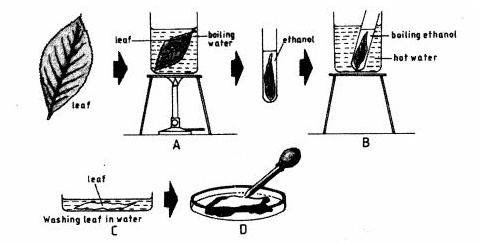
Biology Paper 2 (231/2)
SECTION A (40 marks)
Answer all the questions in this section in the spaces provided.
1 The set-up below illustrates a procedure that was carried out in the laboratory with a leaf plucked from a green plant that had been growing in sunlight.

(i) What was the purpose of the above procedure? (1 mark)
(ii) Give reasons for carrying out steps A, B and C in this procedure. (3 marks)
A ………………………..
B …………………………
C …………………………
(iii) Name the reagent that was used at the step labelled D. (1 mark)
(iv) State the expected result on the leaf after adding the reagent named in (iii) above. (1 mark)
2 In humans, hairy ears is controlled by a gene on the Y Chromosome.
(a) Using letter Y“ to represent the chromosome carrying the gene for hairy ears, work out a cross between a hairy cared man and his wife. (4 marks)
(b) (i) What is the probability of the girls having hairy ears? (1 mark)
(ii) Give a reason for your answer in (b(i) above. (1 mark)
(c) Name two disorders in humans that are determined by sex-linked genes. (2 marks)
(d) Explain how comparative embryology is an evidence for organic evolution. (2 marks)
3 (a) Name the causative agents for the following respiratory diseases. (2 marks)
(i) Whooping cough.
(ii) Pneumonia.
(b) Describe how oxygen in the alveolus reaches the red blood cells. (4 marks)
(c) How are the pneumatophores adapted to their function? (2 marks)
4 (a) The diagram below represents a section of the human brain.

(i) Name the structures labelled P and R. (2 marks)
P ……………………………
R …………………………..
(ii) State two functions of the part labelled Q. (2 marks)
(b) (i) Name two reproductive hormone secreted by pituitary glands in women (2 marks)
(ii) state the function of each of the hormones named in (b)(i) above (2 marks)
5 (a) The diagram below represents a flower

(i) On the diagram, name two structures where meiosis occurs. (2 marks)
(ii) How is the flower adapted to prevent self-pollination? (2 marks)
(b) The diagram below represents a human reproductive organ.

(i)Explain two adaptations of the structure labelled L to its functions. (2 marks)
2 arks) (ii) Explain the role of the gland labelled K.(2 marks)
SECTION B (40 marks)
Answer question 6 (compulsory) and either question 7 or 8 in the spaces provided after question 8.
6 (a) An experiment was carried out to investigate the population of a certain micro-organism. Two petri-dishes were used. Into the petri-dish labelled M. 60cm3 of a culture medium was placed while 3()cm3 of the same culture medium was placed in petri-dish labelled N. Equal numbers of the micro-organisms were introduced in both petri-dishes. The set-ups were then incubated at 35°C. The number of micro-organisms in each petri-di sh was determined at irregular intervals for a period of 60 hours. The results were as shown in the table below.

(i) On the same axes, draw the graphs of relative number of micro-organisms against time on the grid provided. (7 marks)

(ii) After how many hours was the difference between the two populations greatest? (1 mark)
(iii) Work out the difference between the two populations at 50 hours. (2 marks)
(iv) With a reason state the effect on the population of micro-organisms in petri-dish M if the temperature was raised to 60°C after 20 hours. (2 marks)
(v) Account for the shape of the curve for population in petri-di sh N between 46 hours and 59 hours. (3 marks)
(b) Explain how the osmotic pressure in the human blood is maintained at normal level. (5 marks)
7 (a) Explain how structural features in terrestrial plants affect their rate of transpiration.(13 marks)
(b) Explain how the human skin brings about cooling of the body on a hot day. (7 marks)
8 (a) Describe the exoskeleton and its functions in insects. (13 marks)
(b) Describe how accommodation in the human eye is brought about when focusing on a near object. (7 marks)